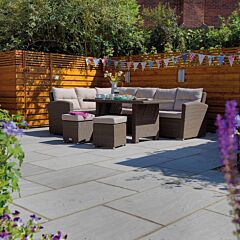Free Delivery Available
WhatsApp Paving Direct
Save up to 50% - clearance stock
-
01993 608 824 - Open Mon-Fri 8am-5pm

Sawn Kandla Light Grey - This light grey natural sandstone paving slab with dark grey highlights has straight crisp edges and a light riven surface.
See Full DescriptionSawn Kandla Light Grey - This light grey natural sandstone paving slab with dark grey highlights has straight crisp edges and a light riven surface.
See Full DescriptionSawn Kandla Light Grey derives its name from the sawn straight linear edges of each paving tile and adds a stylish, opulent and contemporary feel to the landscape.
Natural stone means natural variation! Please remember that natural stone paving is a processed natural product and therefore has unique and intrinsic elements, markings, features, patterns, hues and tones within the stone that makes each slab distinct. This is the essential characteristic that natural stone offers and what makes it so special, and why it works so well in landscaping and garden design. Each stone is entirely unique, and within each paving pack there is natural variation of each stone. When these individual unique slabs are blended and laid together, you get a tapestry of harmonious, but different slabs. And this natural relationship between the slabs is what gives stone paving its essential charm and beauty.
If you are looking for more uniformity and control of colours and patterns, then porcelain paving or concrete paving might be more what you want.
Natural stone will appear differently in varied lighting conditions, so in bright sunshine versus cloud your patio will have a different appearance. Likewise, the angle of the sun will also change the appearance of your paving. The biggest difference in appearance will be wet versus dry stone. Stone is porous, and therefore, rainfall will penetrate the stone, making it darker and making colours and pigments in the stone appear more vivid. These changes in the appearance are also part of the character you are buying into when you choose stone paving for your patio. It is a natural product, and it is a dynamic canvas that reflects the weather and lighting conditions as they change.
To install and lay stone patio paving slabs, you'll need to do the following steps:
To calculate the areas of paving in square-metres (m2), the amount of sub-base hardcore or the amount of sand and cement you'll need for the mortar mix bedding course, please refer to our paving calculators.
For the full step-by-step guide with videos for each step, see our How to Lay Patio Paving Slabs article.
Stone is a porous material and contains tiny capillaries and micro-fissures throughout its structure. Consequently, stone paving is susceptible to water-based chemical erosion (acidic corrosion), physical erosion (frost action), and from staining from waterborne grime, salts and other mineral and particulate deposits. Therefore, as the UK has high winter humidity (generally 80-90%) and damp conditions are the norm, we recommend that you help protect and elongate the life of your paving by sealing the slabs against the water/damp based issues. Our impregnating sealers are designed to enter the capillaries and micro-fissures in the slabs, blocking those spaces to prevent water entering the paving.
In addition to sealing the slabs, we recommend ensuring you brush away leaves, dirt and other detritus regularly, especially in the autumn and winter when leaves, twigs, seeds and other windfall materials are likely to fall on your patio. If left on your paving, especially if damp, and worse still, allowed to rot down and become mulch-like, your paving will almost certainly acquire brown stains from the release of tannins from the windfall materials (think a used tea bag left on a kitchen counter for a model of what will happen).
As well as brushing off dirt and windfall materials, give your patio a hose down with water every so often. Use a low-pressure hose or keep any jet-wash far enough away from the slabs to ensure you don't damage them with the high-pressure water jet. For more stubborn stains and the build-up of grime, we recommend using a specialist non-acidic patio cleaner that will help lift out the dirt and grime.
| Single Size Pack 35 Pieces (900 x 600 x 20 mm) | 1 x Sample (200 x 100 mm Slip) | |
|---|---|---|
| No. of Pieces | 35 | 1 |
| Pack Coverage (m²) | 19.13 | 0.02 |
| Range | Sawn Sandstone | Sawn Sandstone |
| Prod Type | Stone Paving Slabs | Sample |
| Material | Sandstone | Sandstone |
| Finish | Riven | Riven |
| Finish (Edge) | Sawn | Sawn |
| Colour | Light Grey | Light Grey |
| Colour Group | Grey | Grey |
| Dimension (W) | 900 | 200 |
| Dimension (H) | 600 | 100 |
| None | 20 | |
| Interior / Exterior | Exterior | Exterior |
| Pack Contents | 900 x 600 | Sample |
| Pack Sold As | Single Size Pack | Sample |
| Pack Description |
900 x 600 Qty 35 |
1 x sample |
| Pieces Description | Paving Slabs | sample |
Usually replenished within days